Today Marks The 78th Anniversary Of D-Day

Today marks the anniversary of D-Day, arguably one of the most important dates in human history. 78 years ago, 1.5 MILLION allied troops answered the call, opening the second front that marked the beginning of the end for the Nazis. Beyond Americans and Brits, there were troops from Canada, Poland, Australia, New Zealand, Belgium, Czechoslovakia, Greece, The Netherlands, Norway and more. Among them, 226,000 would be killed or wounded in the next few few months of Operation Overlord. That number is just insane to even write out. Instead of going over the events, which most of you reading this know, I wanna show you some of the award citations. I poured through the lists of all the allied countries involved and these are the ones that stood out.
Medal of Honor
John J. Pinder Jr.
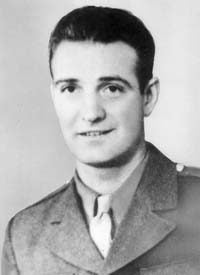
On 6 June 1944, near Colleville-sur-Mer, France. On D-day, Technician 5th Grade Pinder landed on the coast 100 yards off shore under devastating enemy machinegun and artillery fire which caused severe casualties among the boatload. Carrying a vitally important radio, he struggled towards shore in waist-deep water. Only a few yards from his craft he was hit by enemy fire and was gravely wounded.
Technician 5th Grade Pinder never stopped. He made shore and delivered the radio. Refusing to take cover afforded, or to accept medical attention for his wounds, Technician 5th Grade Pinder, though terribly weakened by loss of blood and in fierce pain, on 3 occasions went into the fire-swept surf to salvage communication equipment. He recovered many vital parts and equipment, including another workable radio. On the 3rd trip he was again hit, suffering machinegun bullet wounds in the legs. Still this valiant soldier would not stop for rest or medical attention. Remaining exposed to heavy enemy fire, growing steadily weaker, he aided in establishing the vital radio communication on the beach.
While so engaged this dauntless soldier was hit for the third time and killed. The indomitable courage and personal bravery of Technician 5th Grade Pinder was a magnificent inspiration to the men with whom he served.
Second Lt. John Edward Butts
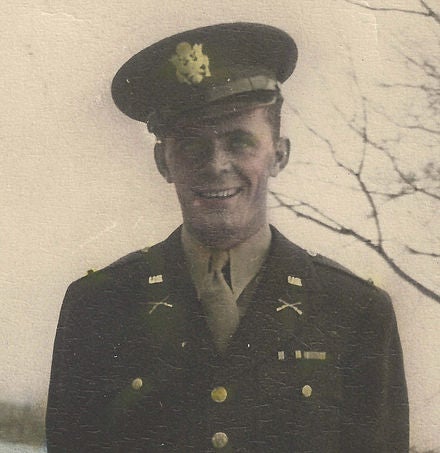
Second Lt. Butts heroically led his platoon against the enemy in Normandy, France, on 14, 16 and 23 June, 1944. Although painfully wounded on the 14th near Orglandes and again on the 16th while spearheading an attack to establish a bridgehead across the Douve River, he refused medical aid and remained with his platoon. A week later, near Flottemanville Hague, he led an assault on a tactically important and stubbornly defended hill studded with tanks, antitank guns, pillboxes, and machinegun emplacements, and protected by concentrated artillery and mortar fire.
“As the attack was launched, Second Lt. Butts, at the head of his platoon, was critically wounded by German machinegun fire. Although weakened by his injuries, he rallied his men and directed one squad to make a flanking movement while he alone made a frontal assault to draw the hostile fire upon himself. Once more he was struck, but by grim determination and sheer courage continued to crawl ahead. When within ten yards of his objective, he was killed by direct fire.
Technical Sgt. Frank D. Peregory
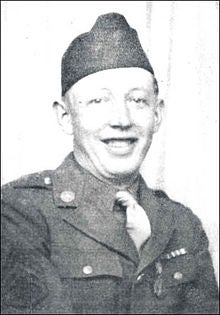
On 8 June 1944, the 3d Battalion of the 116th Infantry was advancing on the strongly held German defenses at Grandcampe, France, when the leading elements were suddenly halted by decimating machinegun fire from a firmly entrenched enemy force on the high ground overlooking the town.
“After numerous attempts to neutralize the enemy position by supporting artillery and tank fire had proved ineffective, Technical Sgt. Peregory, on his own initiative, advanced up the hill under withering fire, and worked his way to the crest where he discovered an entrenchment leading to the main enemy fortifications 200 yards away. Without hesitating, he leaped into the trench and moved toward the emplacement.
“Encountering a squad of enemy riflemen, he fearlessly attacked them with hand grenades and bayonet, killed eight and forced three to surrender. Continuing along the trench, he single-handedly forced the surrender of 32 more riflemen, captured the machine gunners, and opened the way for the leading elements of the battalion to advance and secure its objective.
First Lt. Jimmie W. Monteith Jr.
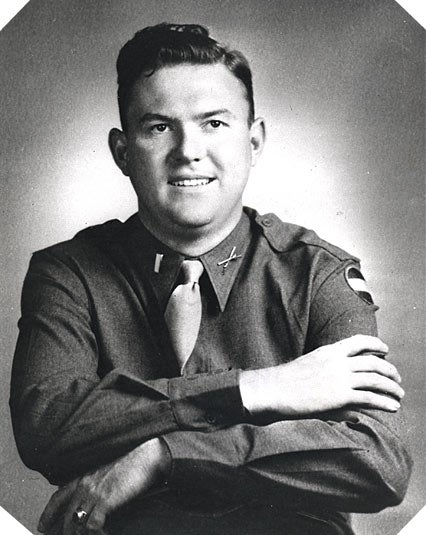
First Lt. Monteith landed with the initial assault waves on the coast of France under heavy enemy fire. Without regard to his own personal safety he continually moved up and down the beach reorganizing men for further assault. He then led the assault over a narrow protective ledge and across the flat, exposed terrain to the comparative safety of a cliff.
“Retracing his steps across the field to the beach, he moved over to where two tanks were buttoned up and blind under violent enemy artillery and machinegun fire. Completely exposed to the intense fire, First Lt. Monteith led the tanks on foot through a minefield and into firing positions. Under his direction several enemy positions were destroyed. He then rejoined his company and under his leadership his men captured an advantageous position on the hill.
“Supervising the defense of his newly won position against repeated vicious counterattacks, he continued to ignore his own personal safety, repeatedly crossing the 200 or 300 yards of open terrain under heavy fire to strengthen links in his defensive chain. When the enemy succeeded in completely surrounding First Lt. Monteith and his unit and while leading the fight out of the situation, First Lt. Monteith was killed by enemy fire.
Pvt. First Class Charles N. DeGlopper

“PFC DeGlopper was a member of [the] 82d Airborne Division, on 9 June 1944 advancing with the forward platoon to secure a bridgehead across the Merderet River at La Fiere, France. At dawn the platoon had penetrated an outer line of machineguns and riflemen, but in so doing had become cut off from the rest of the company.
“Vastly superior forces began a decimation of the stricken unit and put in motion a flanking maneuver which would have completely exposed the American platoon in a shallow roadside ditch where it had taken cover. Detecting this danger, PFC DeGlopper volunteered to support his comrades by fire from his automatic rifle while they attempted a withdrawal through a break in a hedgerow 40 yards to the rear.
“Scorning a concentration of enemy automatic weapons and rifle fire, he walked from the ditch onto the road in full view of the Germans, and sprayed the hostile positions with assault fire. He was wounded, but he continued firing. Struck again, he started to fall; and yet his grim determination and valiant fighting spirit could not be broken. Kneeling in the roadway, weakened by his grievous wounds, he leveled his heavy weapon against the enemy and fired burst after burst until killed outright.
Pvt. Joe Gandara

On [9 June 1944], Pvt. Gandara’s detachment came under devastating enemy fire from a strong German force, pinning the men to the ground for a period of four hours. Pvt. Gandara voluntarily advanced alone toward the enemy position. Firing his machinegun from his hip as he moved forward, he destroyed three hostile machineguns before he was fatally wounded.
“Pvt. Gandara’s extraordinary heroism and selflessness at the cost of his own life, above and beyond the call of duty, are in keeping with the highest traditions of military service and reflect great credit upon himself, his unit and the United States Army.
Victoria Cross Winner
Sergeant-Major Stan Hollis
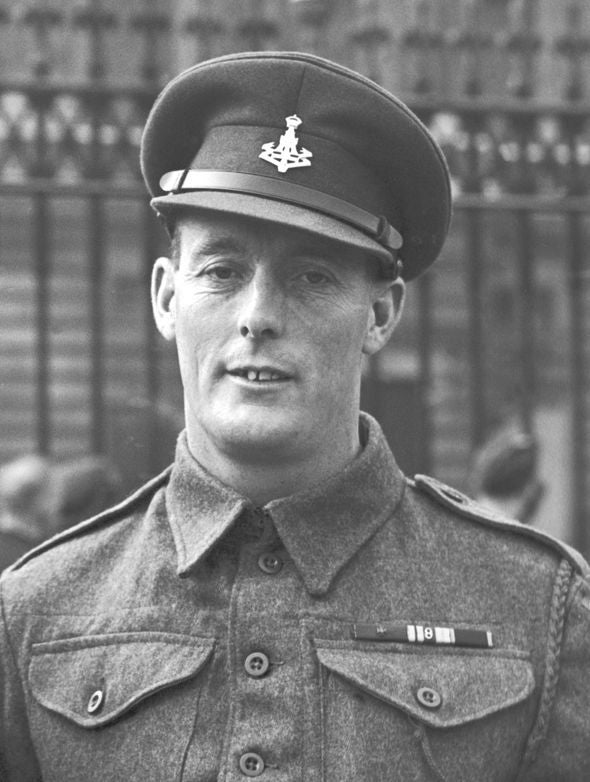
In Normandy on 6 June 1944 Company Sergeant-Major Hollis went with his company commander to investigate two German pill-boxes which had been by-passed as the company moved inland from the beaches. "Hollis instantly rushed straight at the pillbox, firing his Sten gun into the first pill-box, He jumped on top of the pillbox, re-charged his magazine, threw a grenade in through the door and fired his Sten gun into it, killing two Germans and taking the remainder prisoners.
Later the same day… C.S.M. Hollis pushed right forward to engage the [field] gun with a PIAT [anti-tank weapon] from a house at 50 yards range… He later found that two of his men had stayed behind in the house…In full view of the enemy who were continually firing at him, he went forward alone…distract their attention from the other men. Under cover of his diversion, the two men were able to get back.
Wherever the fighting was heaviest…[he]…appeared, displaying the utmost gallantry… It was largely through his heroism and resource that the Company's objectives were gained and casualties were not heavier. ….he saved the lives of many of his men
Canadian Victoria's Cross
Lieutenant-colonel David Vivian Currie
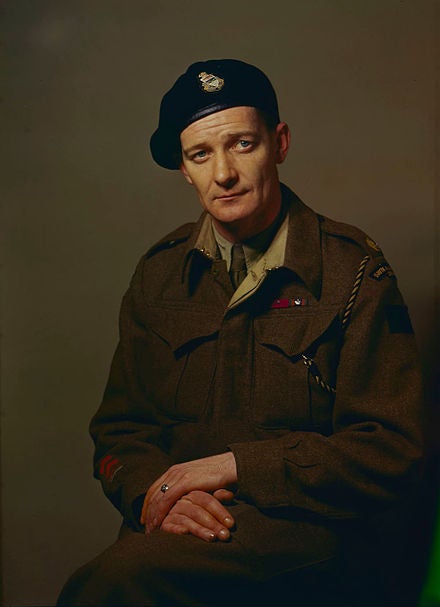
In Normandy on 18th August, 1944, Major Currie was in command of a small mixed force of Canadian tanks, self-propelled anti-tank guns and infantry which was ordered to cut one of the main escape routes from the Falaise pocket.
This force was held up by strong enemy resistance in the village of St. Lambert sur Dives and two tanks were knocked out by 88 mm guns. Major Currie immediately entered the village alone on foot at last light through the enemy outposts to reconnoitre the German defences and to extricate the crews of the disabled tanks, which he succeeded in doing in spite of heavy mortar fire.
During the next 36 hours the Germans hurled one counter-attack after another against the Canadian force but so skilfully had Major Currie organised his defensive position that these attacks were repulsed with severe casualties to the enemy after heavy fighting.
At dusk on 20th August the Germans attempted to mount a final assault on the Canadian positions, but the attacking force was routed before it could even be deployed. Seven enemy tanks, twelve 88 mm. guns and forty vehicles were destroyed, 300 Germans were killed, 500 wounded and 2,100 captured. Major Currie then promptly ordered an attack and completed the capture of the village, thus denying the Chambois-Trun escape route to the remnants of two German armies cut off in the Falaise pocket.
On one occasion he personally directed the fire of his command tank on to a Tiger tank which had been harassing his position and succeeded in knocking it out. During another attack, while the guns of his command tank were taking on other targets of longer ranges, he used a rifle from the turret to deal with individual snipers who had infiltrated to within fifty yards of his headquarters. The only time reinforcements were able to get through to his force, he himself led the forty men forward into their positions and explained the importance of their task as a part of the defence. When, during the next attack, these new reinforcements withdrew under the intense fire brought down by the enemy, he personally collected them and led them forward into position again, where, inspired by his leadership they held for the remainder of the battle. His employment of the artillery support, which became available after his original attack went in, was typical of his cool calculation of the risks involved in every situation. At one time, despite the fact that short rounds were falling within fifteen yards of his own tank, he ordered fire from medium artillery to continue because of its devastating effect upon the attacking enemy in his immediate area.
Virtuti Militari(Poland)
Stanisław Maczek

Attached to First Canadian Army, Maczek's men entered combat on August 8 during Operation Totalize. The division twice suffered serious bombings by Allied aircraft, yet achieved a brilliant victory against the Wehrmacht in the battles for Mont Ormel, Hill 262 and the town of Chambois. In this series of offensive and defensive operations, which came to be known as the Battle of Falaise, 14 German Wehrmacht and SS divisions were trapped in the huge Chambois pocket and destroyed. Maczek's division had the crucial role of closing the pocket to block the escape route of the German divisions
In addition to these guys mentioned, there were obviously countless other acts of bravery during the span of this operation and beyond. A lot of us like to read about broad scope events from the war and stuff like that, but the individual stories from veterans and citations are what I think should get more shine. Just reading some of that superhuman feats some of these guys did to help not only win the war but to save their comrades will put your own life into perspective about as quickly as anything.
If you're looking for something to watch today, there is Band of Brothers(HBO), Saving Private Ryan(Netflix, Paramount+), The Longest Day(Prime rental), Overlord(1975 not 2018, Prime rental), The Big Red One(Prime rental), Patton(kinda (Roku, Prime, Hulu, Starz). There are also a lot of docs you can watch, but I would recommend interviews vs that.


